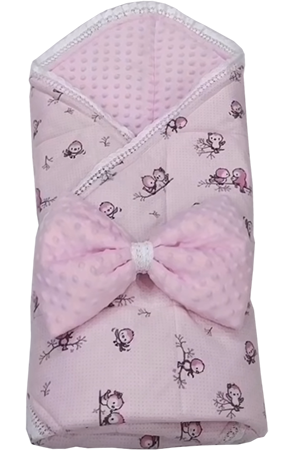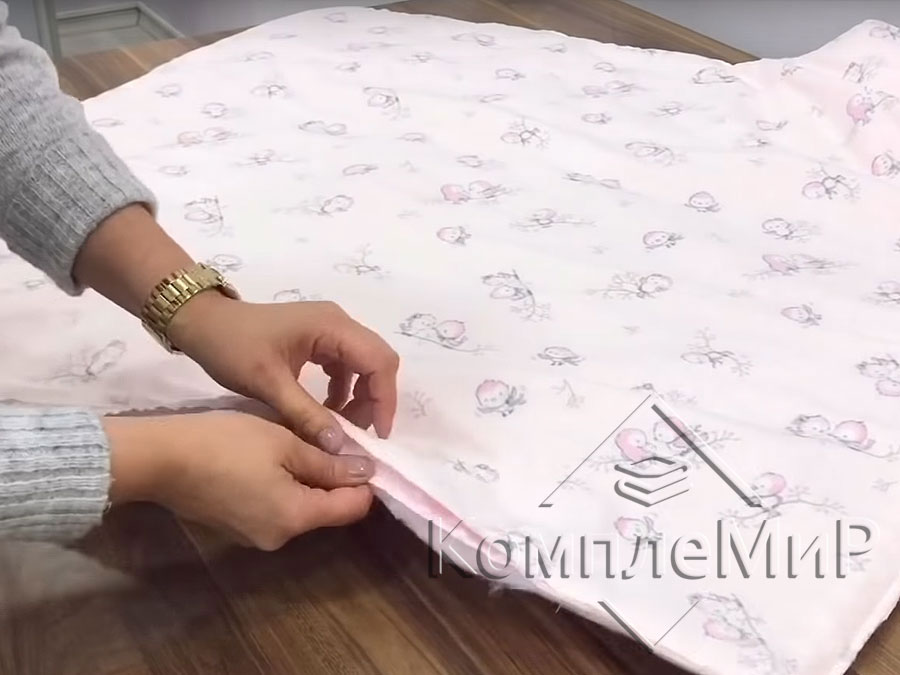At first glance, it may seem that it is quite difficult to sew a baby envelope for a newborn for discharge, due to the presence of various decorative elements on it and its unusual shape. Therefore, many people prefer not to bother with this case and buy an envelope for the statement already in the finished form.
In fact, this is not the case.If we proceed from its standard size and the mandatory elements that must be present on it, without any tricks of creative thought, then it is quite easy and simple to do this, having at hand a sewing machine, scissors,needle and thread, pins and a centimeter tape measure.
And of course, the material itself, from which you need to cut out and sew an envelope for the baby.
We will demonstrate step-by-step how to cut out and sew a standard children's envelope with lace with your own hands, which will include: a blanket measuring 100 cm by 100 cm, a bow and a fixing belt.

1 step - preparation of the material for sewing the blanket under the envelope
The pattern of the envelope is elementary. You need 3 canvases measuring 100 cm by 100 cm and lace to give the pattern:

The first canvas is a heater. This is polyester fiber & ndash; sintepon. Usually, for the demi-season version, a sintepon with a density of 200 g/m2 is taken (in the section, the thickness is 2 cm). For the winter version, you can take a tighter one. It is used in the envelope as a cushioning, internal material.
The second canvas is plush. Fabric with a pile, a pattern on the front side, a kind of velvet. It can be used in the process of operation as the internal and external matter of the envelope.
The third fabric is 100% cotton, calico. Also, both the inner and outer envelope matter can be used.
2 step - fastening the lace needles to the fabric (3rd cloth) around the perimeter
Before you attach the lace to the edge of the fabric, we will make a rounding from one corner of the canvas (fabric - calico), to smooth out the part of the blanket that we will cover the baby's face.

After rounding, we apply and grab the lace with needles to the edges of the fabric around the perimeter.

3 step - linear marking on the plush for subsequent stitching
Moving on to the plush. We make a marking with a simple pencil or chalk on the surface of the plush to determine the direction of the subsequent stitch of our blanket. From the center of the canvas diagonally, you need to step back 35 cm and draw lines parallel to the main axis.

step 4 - crop the corner and stitch all the layers
We turn over the already processed third layer (the fabric with the lace attached) so that the lace is at the bottom, and put it on the marked plush. Plush, in turn, is applied to the sintepon (insulation).

In the end, we got a "sandwich" of three canvases, one of the edges of which must be cut (rounded) in accordance with the shape of the top layer (fabric with lace attached).

After that, we sew our blank (from three layers) around the perimeter (0.5 cm from the edge with a regular seam). At the same time, it is necessary to leave a gap of 30 cm on one side to be able to turn out our blanket after sewing.

We sew the resulting 3-layer "sandwich" on a sewing machine.

We find a pocket and turn out our blanket.



As a result, one side of our baby blanket will look like this.

And the opposite one is like this.

5 step - preparing and stitching the blanket
On the side where the plush with the drawn markings, it is necessary to grab all three layers of our blanket with a needle and thread along the contour lines, to fix them during its subsequent stitch.


Stitch the blanket along its edges (1 cm from the edge along the perimeter) and along the contour lines.


So, the baby blanket, as the main element of the envelope for the newborn, is ready.

step 6 - we sew a bow for the envelope
The billet for the bow will be made of plush and sintepon. The original size of the plush is 70 cm by 28 cm.

We make it in 2 additions.

We put it on a sintepon of the same size as the plush, which in double addition will be 35 cm by 28 cm.

We fix the sintepon to the plush with needles.

We roll our blank from 3 sides in 1.5 cm from the edge. The 4th side will be a pocket - in order to be able to erode our bow from the inside.

We pull out the fixing needles and turn out the bow through the pocket.

We pull the sides of the workpiece to the center and tie it with a thread.

In a circle, we wrap the lace and sew this place by hand.

The bow for the envelope is ready.

7 step - we sew the fixing belt for the envelope
The blank for the fixing belt will be made of plush. We cut out a plush 140 cm long and 6-7 cm wide (1 cm more than the width, in the future, of the built-in elastic band).
We connect the ends of our billet along the entire length and stitch it on a sewing machine.

We turn out our belt.

We put an elastic band in the belt. The length of the elastic band should be 2 times less than the length of the belt itself. That is, if the belt is 140 cm, then the sewn elastic band is 70 cm.

As a result, the belt will take the form of an "accordion", which must still be stitched in the center of the entire length, for complete internal fixation of the elastic band with the belt.

We connect and sew the ends of the belt. The locking belt for the envelope is ready.

We sew a bow to the belt.

Our set of baby quilts, a bow and a locking belt for the envelope for the discharge is ready.

 +375 29 34 37 358
+375 29 34 37 358 +375 33 34 37 368
+375 33 34 37 368










 !
! !
!



























